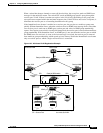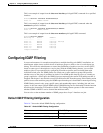
16-19
Catalyst 2950 Desktop Switch Software Configuration Guide
78-11380-05
Chapter 16 Configuring IGMP Snooping and MVR
Configuring IGMP Filtering
This is an example of output from the show mvr interface privileged EXEC command for a specified
interface:
Switch# show mvr interface fastethernet0/2
224.0.1.1 DYNAMIC ACTIVE
This is an example of output from the show mvr interface privileged EXEC command when the
members keyword is included:
Switch# show mvr interface fastethernet0/2 members
224.0.1.1 DYNAMIC ACTIVE
This is an example of output from the show mvr members privileged EXEC command:
Switch# show mvr members
MVR Group IP Status Members
------------ ------ -------
224.0.1.1 ACTIVE Fa0/1(s), Fa0/2(d)
224.0.1.2 ACTIVE Fa0/1(s)
224.0.1.3 ACTIVE Fa0/1(s)
224.0.1.4 ACTIVE Fa0/1(s)
224.0.1.5 ACTIVE Fa0/1(s)
<output truncated>
Configuring IGMP Filtering
In some environments, for example metropolitan or multiple-dwelling unit (MDU) installations, an
administrator might want to control the set of multicast groups to which a user on a switch port can
belong. This allows the administrator to control the distribution of multicast services, such as IP/TV,
based on some type of subscription or service plan. With the IGMP filtering feature, you can filter
multicast joins on a per-port basis by configuring IP multicast profiles and associating them with
individual switch ports. An IGMP profile can contain one or more multicast groups and specifies
whether access to the group is permitted or denied. If an IGMP profile denying access to a multicast
group is applied to a switch port, the IGMP join report requesting the stream of IP multicast traffic is
dropped, and the port is not allowed to receive IP multicast traffic from that group. If the filtering action
permits access to the multicast group, the IGMP report from the port is forwarded for normal processing.
IGMP filtering controls only group specific query and membership reports, including join and leave
reports. It does not control general IGMP queries. IGMP filtering has no relationship with the function
that directs the forwarding of IP multicast traffic. The filtering feature operates in the same manner
whether CGMP or MVR is used to forward the multicast traffic.
You can also set the maximum number of IGMP groups that a Layer 2 interface can join.
Default IGMP Filtering Configuration
Table 16-7 shows the default IGMP filtering configuration.
Table 16-7 Default IGMP Filtering Configuration
Feature Default Setting
IGMP filters None applied
IGMP Maximum number of IGMP groups No maximum set


















